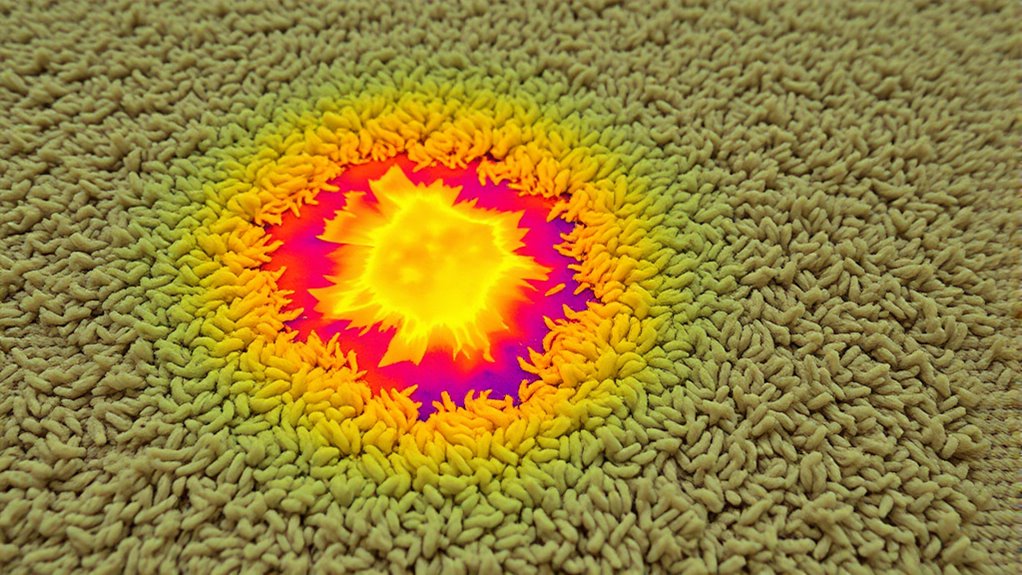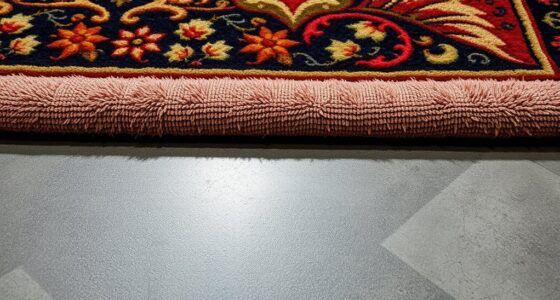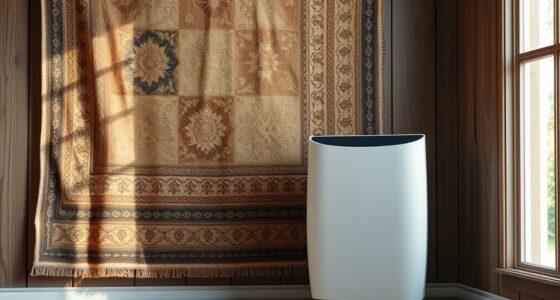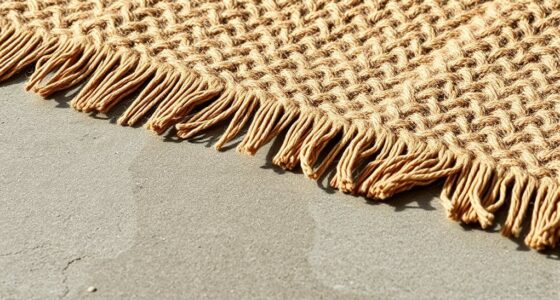Thermal imaging helps you spot hidden moisture under carpets by detecting temperature differences caused by water presence. Wet areas retain heat differently, creating thermal patterns or cooler spots that reveal moisture problems before visible signs appear. Proper calibration and understanding of material properties improve accuracy. Using thermal cameras offers a fast, non-invasive way to identify issues early. Keep exploring to learn how to interpret images and optimize your moisture detection efforts effectively.
Key Takeaways
- Thermal imaging detects cooler areas indicating moisture accumulation beneath carpets by identifying temperature differences.
- Proper calibration of thermal cameras ensures accurate identification of hidden damp spots under carpets.
- Look for irregular thermal patterns or damp spots that retain heat differently, signaling underlying moisture issues.
- Combine thermal imaging with visual inspection and moisture meters for confirmation of hidden water presence.
- Use high-resolution, portable thermal cameras for rapid, non-invasive detection of moisture under carpets in various environments.
How Thermal Imaging Detects Moisture Beneath Surfaces
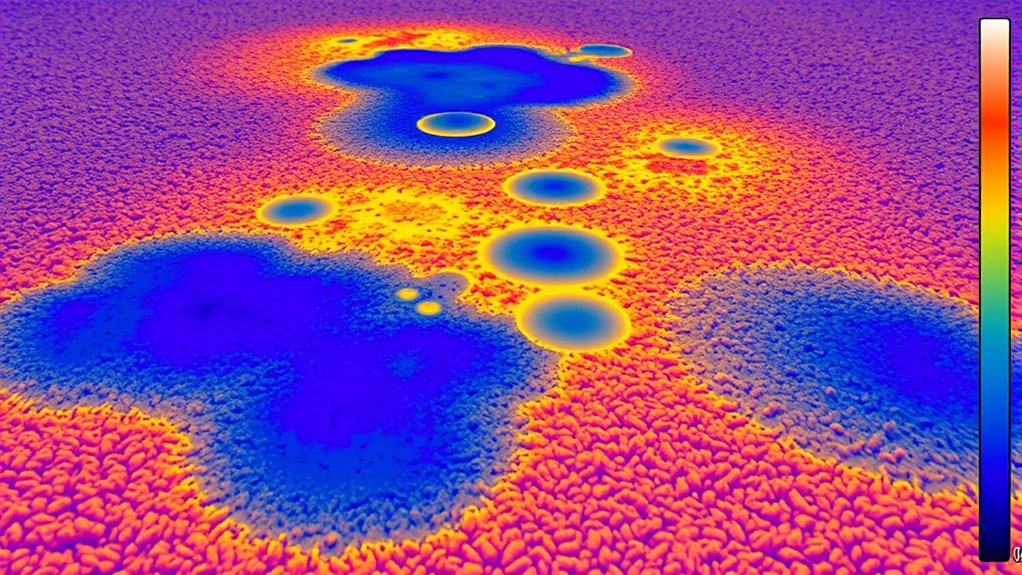
Thermal imaging detects moisture beneath surfaces by capturing temperature differences caused by water presence. When moisture is present, it alters the surface’s thermal conductivity, causing temperature variations that thermal cameras can identify. To guarantee accurate readings, emissivity calibration becomes essential, as different materials emit infrared energy uniquely. Proper calibration adjusts for surface properties, allowing the camera to accurately interpret temperature differences linked to moisture. Moist areas tend to retain or release heat differently than dry regions, creating distinct thermal patterns. By analyzing these patterns, you can locate hidden water pockets without invasive procedures. This precise detection relies on understanding the thermal properties of surfaces and properly calibrating the thermal imaging device to account for emissivity variations, making moisture identification both reliable and efficient. Calibration techniques are crucial for enhancing the accuracy of thermal moisture detection. Additionally, understanding the thermal properties of different materials can significantly improve the detection process, especially when combined with material-specific calibration methods. Incorporating knowledge of thermal conductivity helps refine the interpretation of thermal patterns, leading to more accurate moisture detection results.
Benefits of Using Thermal Cameras for Moisture Detection

Using thermal cameras for moisture detection offers a range of significant advantages. They provide quick, non-invasive assessments, saving you time and effort compared to traditional methods. Thermal cameras identify temperature differences caused by moisture, revealing hidden issues before they worsen. This proactive approach helps prevent costly repairs and mold growth. Here’s a comparison highlighting key benefits:
| Benefit | Description |
|---|---|
| Non-Invasive | No damage or disruption to surfaces during inspection |
| Accurate & Precise | Detects even small moisture differences effectively |
| Time-Saving | Rapid results, reducing inspection time |
| Cost-Effective | Minimizes unnecessary repairs and property damage |
Utilizing thermal imaging can also help you understand moisture migration patterns that could otherwise go unnoticed. Additionally, thermal cameras can assist in risk assessment by identifying areas prone to future issues, which is vital for preventive maintenance strategies. The ability of thermal imaging to detect subtle temperature variations makes it an essential tool in building diagnostics and maintenance. Using a thermal camera for moisture detection enhances your ability to find hidden problems early, saving you money and effort.
Common Signs of Hidden Moisture in Carpets and Flooring
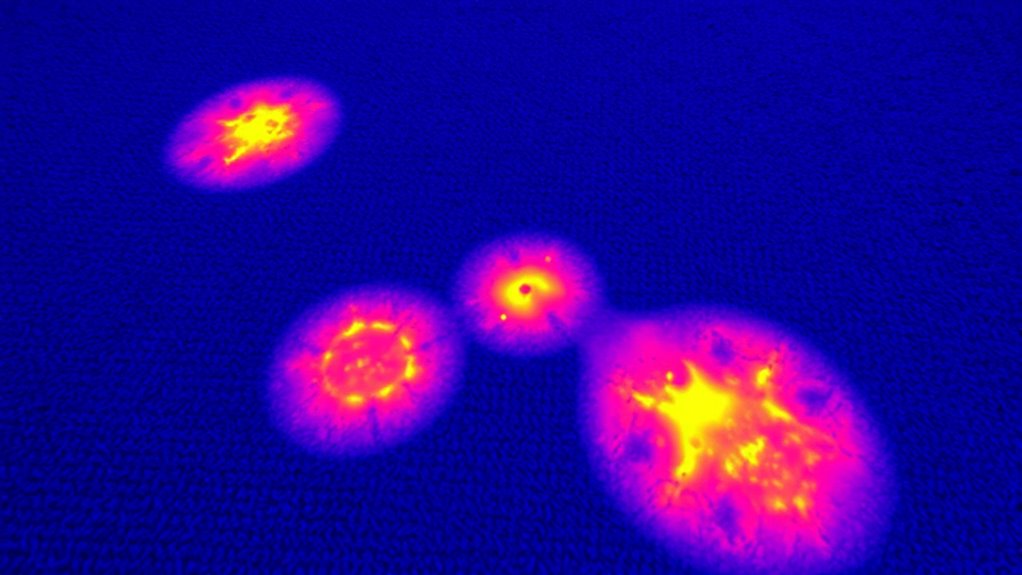
Hidden moisture in carpets and flooring often shows subtle signs that can easily go unnoticed until significant damage occurs. One key indicator is mold growth, which may appear as black, green, or white spots and can cause health issues. You might also notice a persistent, musty odor—an early sign of trapped moisture and mold development. If your carpets feel damp or soft in certain areas, that’s another warning sign. Additionally, discoloration or staining that doesn’t respond to cleaning can indicate underlying moisture. Pay attention to these signs, especially in basements or after spills or flooding. Recognizing mold growth and odor detection early helps prevent extensive damage and keeps your indoor environment safe and healthy. Being aware of Electric Dirt Bike horsepower can also help when evaluating the potential for damage caused by moisture affecting electrical components or batteries in related equipment. Proper moisture detection tools like thermal imaging cameras can assist in identifying hidden dampness behind carpets and walls before visible signs appear.
Step-by-Step Process of Conducting a Thermal Inspection
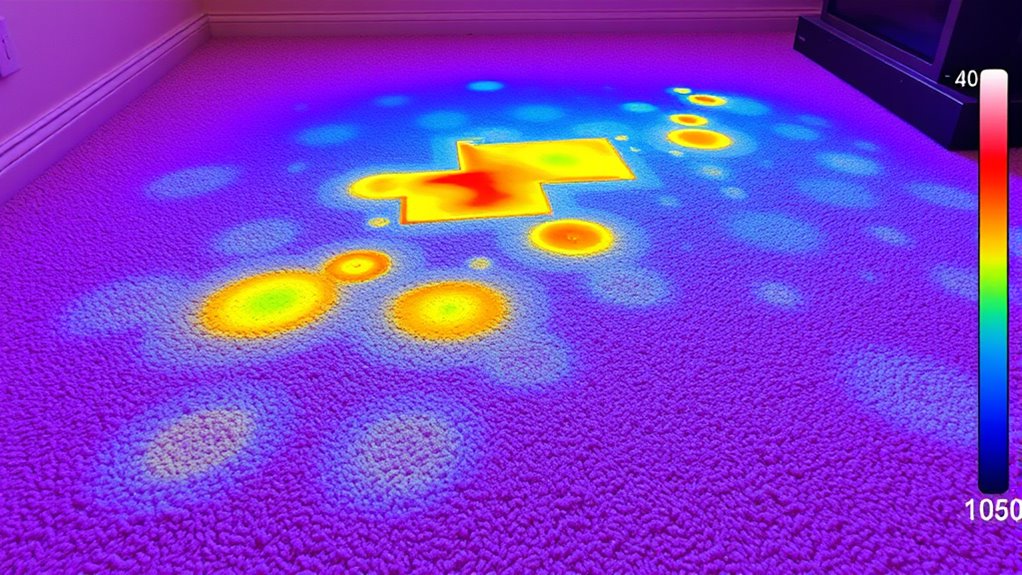
Conducting a thermal inspection involves systematically scanning the area with a thermal camera to detect temperature variations that may indicate hidden moisture. Before starting, verify your thermal camera is properly calibrated to guarantee accurate readings. Begin by slowly sweeping over the carpet and surrounding areas, paying close attention to any cool spots that suggest moisture presence. Keep the camera steady and maintain consistent distance for reliable results. As you scan, look for patterns or anomalies that could identify moisture sources. Use your thermal camera to pinpoint temperature differences, which help in moisture source identification. Once the scan is complete, note the locations of temperature variations for further investigation or moisture testing. Proper calibration and careful observation are key to ensuring an effective and accurate thermal inspection. Additionally, understanding the benefits of thermal imaging can help you interpret the results more accurately and efficiently. Being aware of the industry trends can also provide insights into the latest technological advancements that improve inspection accuracy. Recognizing the impact of insulation on temperature readings can further refine your detection process. Incorporating professional expertise can significantly enhance the accuracy of your moisture detection efforts.
Interpreting Thermal Images to Identify Problem Areas
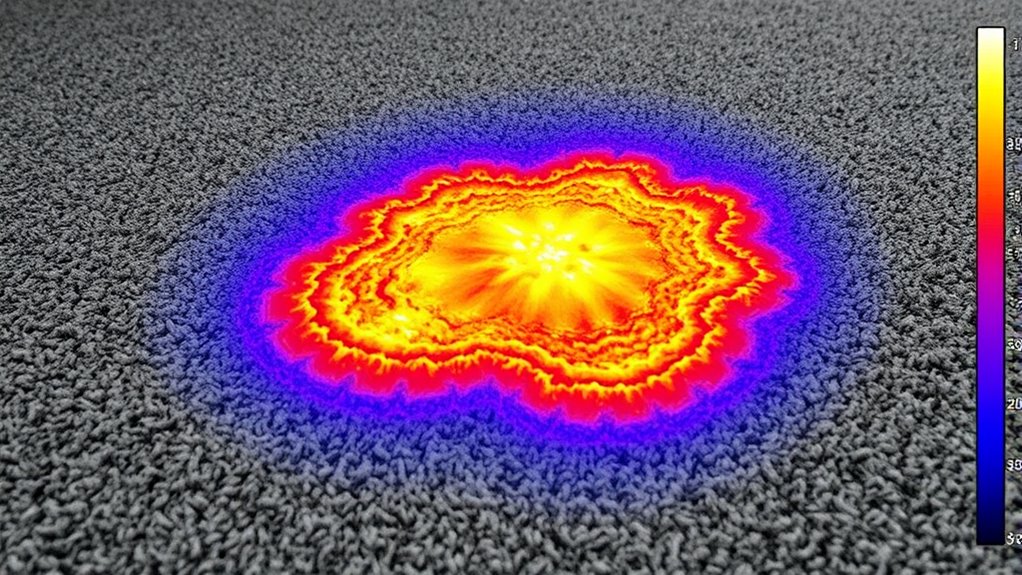
When examining thermal images, you should look for temperature anomalies that stand out from normal patterns. These irregularities often indicate underlying issues, such as heat loss or electrical faults. Additionally, correlating these images with moisture clues can help you pinpoint areas affected by water intrusion or leaks. Recognizing patterns of fathers’ guidance in the imagery can also provide insights into potential problem zones. Utilizing passive voice detection tools can further enhance your ability to interpret these thermal patterns accurately. Considering filtering technologies can improve the clarity of thermal images, making anomalies easier to identify. Being aware of thermal contrast techniques can also aid in distinguishing subtle temperature differences that signal hidden moisture.
Recognizing Temperature Anomalies
Recognizing temperature anomalies in thermal images is essential for identifying potential problem areas. These anomalies often indicate issues like hidden moisture or insulation faults that disrupt normal heat transfer. When you scan a surface, look for areas that appear markedly warmer or cooler than their surroundings. Variations in thermal comfort can hint at moisture accumulation, as wet materials tend to retain heat differently than dry ones. By understanding these irregularities, you can pinpoint spots where heat transfer is affected, signaling possible hidden problems under carpets or walls. Accurate interpretation of temperature differences helps you target areas needing further inspection. Remember, consistent temperature patterns suggest normal conditions, while anomalies alert you to potential issues that may require repair or intervention. Additionally, recognizing sound design principles can help in developing effective thermal imaging techniques for improved detection accuracy. Developing a solid understanding of thermal conductivity can further enhance your ability to interpret subtle temperature variations accurately. Utilizing thermal contrast effectively can also improve the detection of moisture-related anomalies in complex environments. Being aware of thermal resolution can aid in capturing more detailed images for better analysis.
Correlating Images With Moisture
Interpreting thermal images to identify problem areas involves matching temperature patterns with actual moisture presence. Infrared thermography allows you to see surface temperature variations that indicate hidden moisture. Cooler areas on the thermal image often suggest moisture retention because water affects surface temperature, making it lower than dry surroundings. To accurately correlate images with moisture, compare the thermal patterns with physical conditions—damp spots typically show distinct thermal signatures. Keep in mind that surface temperature changes can be influenced by external factors, so consider environmental conditions during inspection. Additionally, advancements like AI Develops Cure for Common Cold and other recent discoveries demonstrate how emerging technologies can enhance diagnostic accuracy. By understanding how moisture impacts surface temperature, you can pinpoint problem areas more effectively, saving time and preventing further damage. Accurate interpretation of thermal images is essential for targeted moisture detection and remediation.
Limitations and Challenges of Thermal Moisture Detection

Despite the advantages of thermal imaging for moisture detection, several limitations and challenges can hinder its effectiveness. Sensor calibration is essential; if not properly calibrated, readings can be inaccurate, leading to false positives or negatives. Environmental interference, such as drafts, temperature fluctuations, or sunlight, can distort thermal images, making moisture detection unreliable. Additionally, surface properties like carpet material or underlying structures can affect heat flow, complicating analysis.
| Challenge | Impact | Solution |
|---|---|---|
| Sensor calibration | Inaccurate moisture readings | Regular calibration before inspections |
| Environmental interference | Distorts thermal images | Conduct inspections in controlled environments |
| Material properties | Affects heat transfer, obscuring moisture | Understand material influence, interpret cautiously |
Comparing Thermal Imaging With Traditional Inspection Methods
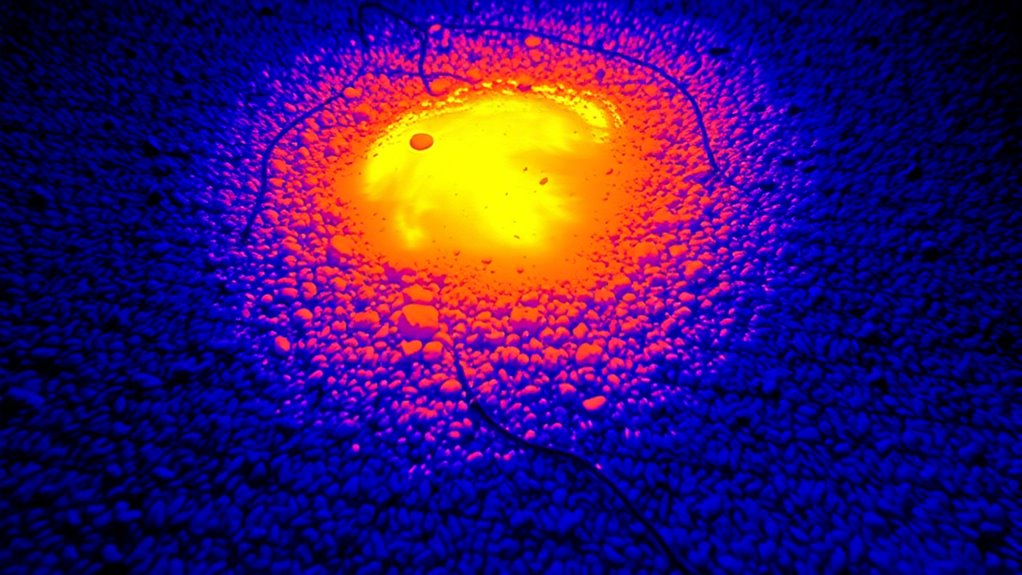
Thermal imaging offers a non-invasive and rapid way to detect moisture issues compared to traditional inspection methods like visual checks and moisture meters. It reveals moisture migration by identifying variations in surface temperature caused by trapped moisture beneath surfaces. Unlike moisture meters, which require direct contact and only test specific spots, thermal imaging scans large areas quickly, providing a comprehensive view of hidden problems. It detects cooler spots that indicate moisture presence, helping you pinpoint problem areas without destructive probing. Traditional methods may miss early signs of moisture migration or surface temperature changes, making thermal imaging a more effective tool for early detection. Overall, thermal imaging enhances accuracy, saves time, and reduces the need for invasive inspections when spotting hidden moisture under carpets.
Practical Tips for Homeowners and Inspectors
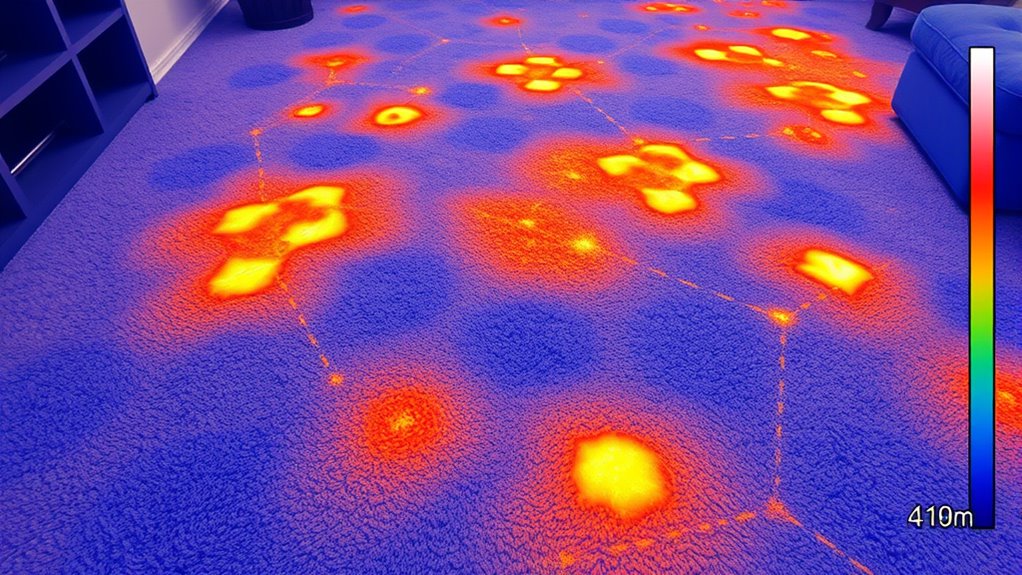
To get the most accurate results with thermal imaging, you should learn how to detect moisture variations and understand their implications. Using the right equipment and knowing how to interpret thermal images are essential skills for homeowners and inspectors alike. These practical tips will help you identify issues early and make sure thorough inspections.
Detect Moisture Variations
Detecting moisture variations with thermal imaging involves looking for temperature differences that indicate hidden water presence. You’ll notice distinct thermal patterns where moisture alters heat flow, creating identifiable moisture signatures. These variations often appear as cooler spots on the thermal image, signaling potential problem areas. To effectively identify moisture, keep these tips in mind:
- Observe consistent temperature differences across surfaces
- Look for irregular or unusual thermal patterns
- Compare suspect areas to surrounding regions
- Note areas with persistent cool spots
- Cross-reference thermal data with visual clues
Use Proper Equipment
Using the right equipment is key to accurately identifying moisture issues with thermal imaging. Make certain your thermal camera has high resolution and sensitivity to detect subtle temperature differences caused by hidden moisture under carpets. Proper calibration is essential for precise readings. Incorporate moisture meters alongside thermal imaging to confirm suspicions; they provide direct moisture content measurements that thermal cameras can’t. When inspecting, pay attention to areas with inadequate thermal insulation, as these spots often show more pronounced temperature variations. Using advanced equipment helps you avoid false positives and ensures reliable results. Remember, combining thermal imaging with moisture meters and understanding how thermal insulation affects heat flow leads to a more thorough assessment of hidden moisture problems.
Interpret Thermal Images
Interpreting thermal images requires careful observation of temperature variations and an understanding of how different materials respond to heat. Look for areas showing unusual thermal contrast, which often indicates moisture migration. Moisture beneath carpets can cause cooler spots that stand out against warmer surroundings. Focus on consistent patterns rather than isolated hot or cold spots, as these may be false indicators. Keep in mind that environmental factors like drafts or sunlight can affect readings. Use these practical tips:
- Identify persistent cool spots indicating possible moisture
- Compare thermal contrast across different areas
- Note changes over time for more accurate detection
- Cross-reference with physical inspections
- Consider material types and their heat response
Accurate interpretation helps you detect hidden moisture before it causes damage.
Future Trends in Moisture Detection Technology

As technology advances, moisture detection methods are becoming more accurate and non-invasive, promising significant improvements in the future. Sensor advancements enable devices to detect moisture more precisely, even in hard-to-reach areas. Integration technologies allow moisture sensors to combine with thermal imaging and smart systems, providing real-time data and quick analysis. Expect innovations like wireless sensors and AI-powered algorithms, which will increase detection speed and reduce false positives. These advancements will make moisture detection more accessible and reliable, helping you identify hidden issues early.
| Technology | Benefits | Applications |
|---|---|---|
| Wireless Sensors | Easy installation | Building diagnostics |
| AI Algorithms | Accurate analysis | Leak detection |
| Thermal & Sensors | Non-invasive | Moisture mapping |
| IoT Integration | Remote monitoring | Continuous assessment |
| Compact Devices | Portability | On-site inspections |
Frequently Asked Questions
Can Thermal Imaging Detect Moisture Through Thick or Insulated Walls?
You wonder if thermal imaging can detect moisture through thick or insulated walls. While thermal penetration is limited by wall insulation, some moisture differences might still be visible if the insulation isn’t too dense. However, highly insulated or thick walls often block thermal signals, making it difficult for thermal imaging to accurately detect hidden moisture. For better results, consider complementary methods like moisture meters alongside thermal imaging.
How Accurate Is Thermal Imaging Compared to Invasive Moisture Testing?
Think of thermal imaging as a detective with a keen eye—it’s quite accurate for detecting moisture, but it’s not foolproof. When comparing moisture accuracy to invasive testing, thermal comparison offers quick, non-invasive results, yet it might miss tiny or deeply hidden spots. You should know that while thermal imaging provides a solid initial assessment, invasive methods remain the gold standard for pinpoint precision.
What Are the Cost Implications of Using Thermal Cameras for Moisture Detection?
When considering thermal cameras for moisture detection, you should do a cost analysis to understand expenses involved. These devices have higher upfront costs compared to traditional methods but can save you money long-term by quickly identifying hidden moisture without invasive testing. Keep your budget considerations in mind, as thermal imaging can be a cost-effective solution for ongoing moisture monitoring, especially when early detection prevents costly repairs later on.
Is Special Training Required to Interpret Thermal Images Effectively?
Think of thermal image interpretation as mastering a new language—you need practice. While basic thermal cameras are user-friendly, developing moisture detection expertise enhances accuracy. Special training isn’t always required, but it’s highly recommended to confidently identify hidden moisture spots. With proper instruction, you’ll quickly learn to distinguish subtle temperature differences, making your moisture detection more precise and reliable. This investment in training pays off by improving your overall diagnostic skills.
How Does Ambient Temperature Affect Thermal Imaging Results?
Ambient temperature greatly impacts thermal imaging results because it influences thermal sensitivity. When the environment is too hot or cold, it can cause temperature differences to appear less distinct, making it harder to detect moisture. You need to take into account ambient temperature carefully, as it affects how accurately your thermal camera can identify hidden issues. Adjusting your camera settings and understanding temperature variations will help you get clearer, more reliable images.
Conclusion
By embracing thermal imaging, you open the door to uncovering hidden moisture before it causes lasting damage. While no method is perfect, this technology offers a gentle way to catch problems early, saving you stress and costly repairs down the line. Trust your instincts, stay vigilant, and let thermal cameras be your quiet guardian—helping you maintain a healthier, more comfortable home for you and your loved ones.
